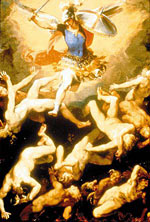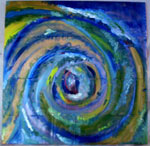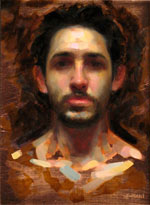Reflections of the Past: The Resurgence of the Copper Canvas
 Archangel Michael and the Rebel Angels by Giusepee Cesari
Archangel Michael and the Rebel Angels by Giusepee Cesari Photograph from Copper as Canvas, Two Centuries of Masterpiece Paintings on Copper, 1575-1775
Copper canvases and the luminescent shine that glows from beneath the paint has survived for almost three centuries, enticing such provocative master painters as El Greco, Brueghel, Reni, Wtewael, Chardin and Rembrandt, among others, who produced fine works on copper. Contrary to popular belief, most masterpieces were not painted on canvas or panels, but on copper metal. (After all, in previous centuries, a person couldn't just stroll into an art store and purchase a canvas, brushes and a variety of paints, as in the modern day world.) Renaissance era artists were extremely creative and tapped into their own mind, creativity, and resources with copper reigning high on the list.
In fact, according to the book, Copper as Canvas: Two Centuries of Masterpiece Painting on Copper, 1575-1775, from an exhibition and catalogue produced by the Phoenix Art Museum in 1999, suppliers of artists' materials are often forgotten when studying art works. However, evidence of their labor and trade materialized from personal marks occasionally found on the reverse of painting supports. And now, thanks to a new wave of contemporary copper artists who appreciate the challenge of working on copper, the craft is experiencing a resurgence.
Karina Keri-Matuszak, a copper artist who creates her magnificent pieces in Dacula, Georgia, an Atlanta-suburb, has discovered a love for oil on copper.
"When I attended high school, I always looked at metal items in actual architecture and books, and it struck me as looking very cool," she says. "It was something different that you didn't see every day. It was exciting and modern, and kind of urban. Whenever I would see a metal sculpture outside a bank, an office or tall building I'd think to myself, 'wow, isn't that cool.' I've always been drawn to modern things as opposed to old world Renaissance painting."

Double Twisted Denim by Karina Keri-Matuszak
Photograph courtesy of Karina Keri-Matuszak
Keri-Matuszak attended London's American College for the Applied Arts for a few semesters, with an initial goal of fashion design. Eventually, she started a wedding gown business with her twin sister, but down the road found her niche in visual arts. At school, she was forced to take art classes and thought herself to be quite a good realistic artist, but when she got on a bigger playing field, she realized the extent of the competition, she says. After being given an assignment to create abstract art, her professor told her she was brilliant, and gave her a top grade, solidifying her calling in abstract arts.
After devoting fifteen years to raising her family, she decided to search for something different in the art world. Her personal goal was to experiment and find an art form that was more eye-catching than the typical still life paintings she had previously crafted. Everything changed for Keri-Matuszak when she was inspired to use copper as the backdrop for her art.
"I was at a festival in Atlanta and saw an artist whose paintings were, (to me), the most fascinating type of art that I ever saw," she explains. "I couldn't stop looking at it. His work was very dainty - tiny triangles and shapes - and I thought that maybe I could also do something with this. I went home and tried to remember what I had seen, but came up with a different version. I began with geometric rectangles, but mine were, and still are, more rustic and have character - everything isn't in its complete, perfect place."
Experimenting with Copper as a Canvas
Many artists purchase copper sheets and copper flashing from local home stores, which Keri-Matuszak used to do, but now she orders rolls of copper sheets from a roofing company. She carefully cuts them in different sizes with industrial or metal shears then sometimes wraps them around a piece of plywood board, like a Christmas package. The reason Keri-Matuszak feels her art is rustic is that people can actually view the panels of copper. According to this talented artist, it takes three sheets of copper to cover a board 24" by 24", which is her standard size.
Another reason she describes her work as 'rustic' is because she nails the copper to the board, letting the retaining nails peek out, even if they're bent. Her copper canvases are varied because of her love of experimentation and eclectic styles that include hammer marks and the projection of an industrial feel. She's also pieced copper together so instead of one sheet going across the board, if the roll is only halfway, she starts a new roll and leaves it there so it looks like a ridge across the painting that often doubles as a design.
"Sometimes I'll build a wooden frame around the outside before I start painting, that provides me with a style that appears just as it is; a sheet of copper on a board. But, I let the edges show and paint the edges black because that's what I think looks the best," she explains. "I also have another style where I wrap a thin piece of plywood with copper and mount that to a black board, so I might have two squares of copper mounted to the black, or maybe three squares of copper that look like a diptych or triptych, but it's really not because it's on one black board, which emphasizes the copper. Then I use a crystal-clear coating, like a protective gloss finish, even before I start painting. All of these steps are done before I begin to paint, and I always use oil paints."
Keri-Matuszak paints as if she's using a regular canvas, but she explains, the copper is extremely slippery to work on. If the copper is too wet the colors run. However, she likes the contrast as it garners a certain appeal, so she leaves the running colors on her copper canvas and many people find it attractive. She also began painting geometric squares that have a stained glass, reflective look to them, especially when hanging by a window so the copper shines through. Sunlight changes the look and illuminates her paintings, she says.
"People always ask me if it's stained glass, but it's not, it's just the copper coming through," she reveals. "From there I branched out to more free-flowing, abstract art with no shape, just different color assortments on copper. They appear more like a burnished sunset or seascape. Another style I have created is kind of surreal, planet-shaped sphere. I like blue backgrounds that look like you're gazing up at a sky. It's created for a different market than the other paintings, but people always come up to me and say it looks like a sci-fi painting. I also have another style that's very popular. It almost looks like a flower, but it's not. I paint a dot in the middle with different colors, like petals, then I swirl the petals into each other to create a different affect. It's all personal a decision. I try to use copper in different styles so at least one of my copper canvases will appeal to everyone. I've seen the work of El Greco and Reni, and have an appreciation of art on all levels, but it's easier for me to accomplish this way."
Reflecting the Tradition of the Copper Canvas Through Contemporary Art
Kate Lehman, another artist leading the resurgence of the copper canvas in the modern art world, gives homage to master painting techniques in her contemporary works.
 Ben Sargent by Kate Lehman, Oil on Copper Leaf on Board
Ben Sargent by Kate Lehman, Oil on Copper Leaf on Board Tiger Moth by Kate Lehman, Oil on Copper Leaf on Board
Tiger Moth by Kate Lehman, Oil on Copper Leaf on BoardPhotographs courtesy of John Pence Gallery
"I began creating copper art about one and a half years ago because I like the color and surface," she says. "I tried to find people who knew about it, but wasn't successful, so I did research and found the book Copper as Canvas: Two Centuries of Masterpiece Painting on Copper, at an art supply store in Brooklyn. It contains some excellent background technique, which really helped me to learn and study this technique. I taught myself and did whatever it said in the book. I learned to scratch the surface of the copper with a regular kitchen sponge that has that 'scrubby' side and created scratch marks using small, circular motions. After that step, I clean and put alcohol on it. But, at that point, people who use this technique have to be careful that they don't get fingerprints on it because they'll eventually show up in the painting. Then, I cut a clove of garlic in half and rub some of the juice on there. That particular method is supposed to help the paint adhere to the surface, and then I paint directly on that, always using oils when I have a copper art piece."
Lehman, resides in Manhattan with her husband, artist Travis Schlaht, and began studying art at age nineteen at the L'academie Roederer in Paris, before focusing on traditional academic techniques at the Minnesota River School of Fine Art with Patrick Devonas, and then, in Brooklyn, studying under Jacob Collins at the Water Street Atelier. Kate is one of the founders and principal instructors at the Grand Central Academy of Art along with Jacob Collins, Michael Grimaldi and Dan Thompson.
At one point, when she was younger, she became interested in the methodologies of the 19th century painters, which was rare for a fifteen-year old girl.
"I've always gone to museums and seen more figurative paintings in general. When I'd draw or paint it was similar to what I saw in museums," she explains. "The school I attended didn't teach any of that so I surmised that you have to be talented to paint that way, that technique isn't something that is learned, you're born with it. It's like any skill, like playing an instrument. You always have to learn the technical aspect, which is the same with drawing a painting. Yet, many schools today don't teach that, they're only interested in the conceptual part of art and the fact that it has to be unique."
Other paintings are in private collections. All of Lehman's copper art paintings are unique and show her unending talent. Prices for her work begins from $2,200 to $15,000 and up, depending on size and complexity.
Karina Keri-Matuszak and Kate Lehman are just two shining examples of American artists leading this exciting movement and highlighting copper's importance in today's contemporary art world. By visiting past techniques and traditions, today's copper painters can continue to discover the mystery of copper and its aesthetic properties, using copper as a medium and an inspiration for their art.
Resources:
Artist Kate Lehman is represented by the John Pence Gallery at 750 Post St., in San Francisco, California.
Also in this Issue:
- Reflections of the Past: The Resurgence of the Copper Canvas
- Chelsea Stone Livens Up Her Jewelry Designs with Copper
- Coppersmithing in New Bedford
- Copper Dead Sea Scroll Displayed for the First Time in America
- Sotheby's Sets New World Record for Bronze Sculpture at Auction: Artemis and the Stag Fetches $28.6 Million
